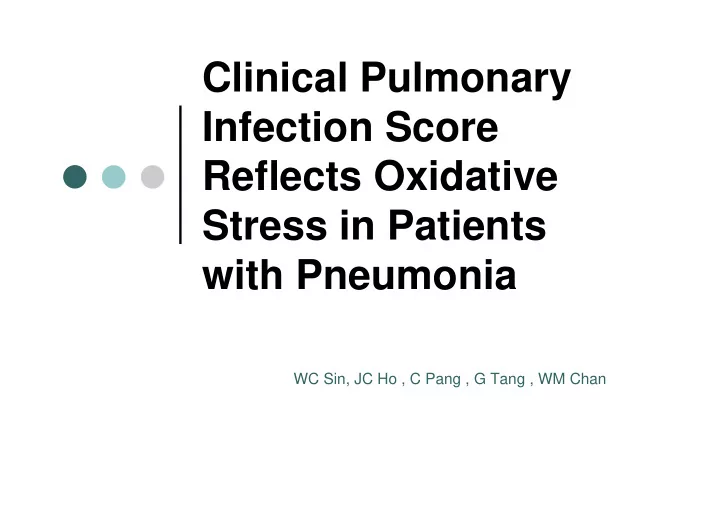

Clinical Pulmonary Infection Score Reflects Oxidative Stress in Patients with Pneumonia WC Sin, JC Ho , C Pang , G Tang , WM Chan
Background (1) Severe CAP and nosocomial pneumonia are common ICU problem with high mortality and morbidity Oxidant-antioxidant imbalance plays an important role in the pathogenesis Trials of supplementing critically ill patients with antioxidants, trace elements and vitamins yield conflicting results May be due to differences in patient selection, baseline severity, timing, choice, route and dose of antioxidant administration.
Background (2) Key for antioxidant supplement: hit fast and hard Therapeutic window • N-acetylcystine in ARDS failed to show benefit in terms of mortality. The initiation of antioxidant in these studies was after the development of organ failure • Avery et al supplemented surgical trauma patients prophylactically with α - tocopherol and ascorbic acid .Organ failure was reduced but this cannot be transformed into mortality benefit.
Background (3) Severity dependent • Selenium in Intensive Care (SIC) study • 249 patients with septic shock • high dose selenium bolus followed by continuous infusion • Predefine –subgroup analysis: mortality was reduced in septic shock patient with disseminated intravascular coagulopathy , in patients with APACHE III score ≧ 102 and in patients with more than three organ dysfunctions
Background (4) Antioxidant measurement is not available as routine in most of the laboratory Need clinical surrogate marker to identify patient early who may be benefit from antioxidant supplementation
Study question To study the role of clinical pulmonary infection score in identifying antioxidant deficient patients with pneumonia in ICU
Method (1) Prospective observational study 9 months period Combined medical and surgical ICU ICU patients with pneumonia severe CAP nosocomial pneumonia preexisting ICU patient with newly diagnosed nosocomial pneumonia ventilator associated pneumonia (VAP) CPIS was evaluated on day 0 and day 3 Antioxidant activity in erythrocytes activity were measured on day 0 and day 3 superoxide dismutase (SOD) catalase Glutathione (GSH)
Antioxidant Antioxidant enzymatic • superoxide dismutase, catalase and glutathione peroxidase • trace elements copper (Cu), selenium (Se), manganese (Mn), and zinc (Zn) as part of the structure of the antioxidant enzymes non-enzymatic vitamins (e.g. vitamin E, C and β -carotene) [5], • uric acid, bilirubin, thiols protein such as cysteine or glutathione (GSH), albumin
Inter-relationship between ROS and Antioxidant
Method (2)-CPIS calculation
Method (3) Exclusion criteria CPIS calculation was inaccurate or baseline serum antioxidant being affected by means of medication or treatment • Known chronic diffuse pulmonary diseases • Patient with positive sputum smear for acid fast bacilli or radiological feature suggestive of tuberculosis • Patient with surgical operation within 7 days of onset of symptoms. • Immunocompromised patient . Defined as white blood cell count < 1000/mm3, recent use of corticosteroid > 10 mg / day for 2 weeks, underlying malignancy, receiving cytotoxic drug or radiation therapy. • Patient taking drugs with antioxidant effect e.g. vitamin A, C, E , statin and N- acetylcystine. • Imminent death or patient with do not resuscitate (DNR) order.
Method (4) Statistic Kolmogorov-Smirnov test to verify the normality of distribution of continuous variables Correlations : Pearson’s or Spearman-rho tests Comparisons between the two groups : Student’s T test or Mann-Whitney U exact test according to their normality of distribution The predictive value of antioxidant concentration on ICU outcome :receiver operator characteristic (ROC) and the area under the curve (AUC) Association between antioxidant level and clinical scoring was adjusted for covariates: Multiple linear regressions P<0.05 was considered significant.
Result (1) : Basic Demographic data
Result (2): Antioxidant level Day 0 Day 3 Catalase* 0.47 (0.22) 0.46 (0.23) (U/g Hb), Mean (SD) SOD # 23.17 (32.26) 26.52 (37.33) (U/g Hb) GSH * 11.16 (2.79) 10.60 (3.08) (umol/g Hb) * In normal distribution # in normal distribution after log transformation
Result (3) There is no linear relationship between antioxidants and CPIS
Result (4): CPIS(8) in discriminating patients with significantly lower catalase level CPIS<8 (0.50 0.24U/gHb vs. 0.33 0.11U/gHb, 95%CI 0.04-0.31) Result was adjusted for age , sex and co-morbidities
Result (5):ROC curve – clinical score Cutoff of CPIS 8 point was found to have the best sensitivities / specificities values for D28 mortality (62.5% / 78.3%). AUC 0.78
Limitations Post hoc analysis CPIS is validated in VAP Valid in severe CAP ? Need further validation study Pneumonia severity index does not include CXR and culture criteria
Limitations Small sample size (N=31) explain no differences in SOD and GSH when a dichotomous cutoff (8) for CPIS was applied study population is small to overcome the bias caused by a heterogeneous group of patients for whom many confounders (appropriate antibiotic treatment, co- medication which could influence redox status, co-morbidities, causative pathogens and transfusion)
Conclusion and Discussion CPIS 8 is an important cut-off point to identify patients who are at risk of antioxidant deficit and death Implication : EARLY selection of patient with pneumonia to receive antioxidant treatment
Thank you
Calculation of sample size Published data on correlation of oxidative stress and clinical score - the r ranges from 0.28-0.426. Assuming r = 0.43 with α =0.05 (two- tailed) and power of 0.8 , 36 patients will be recruited
Recommend
More recommend